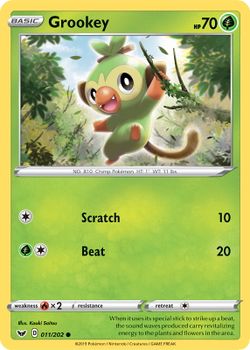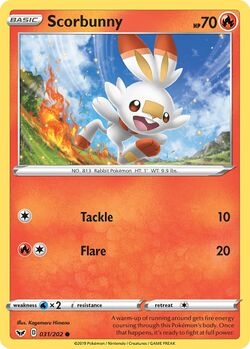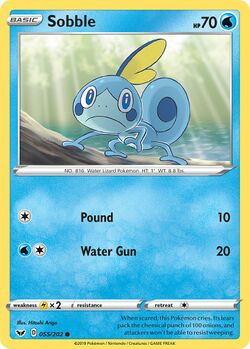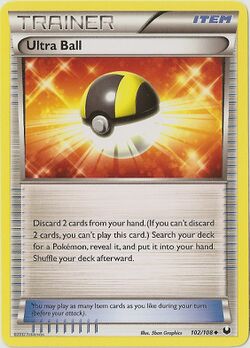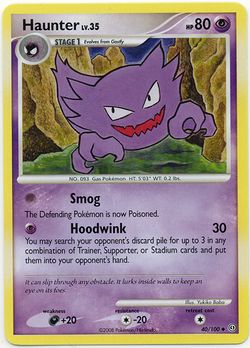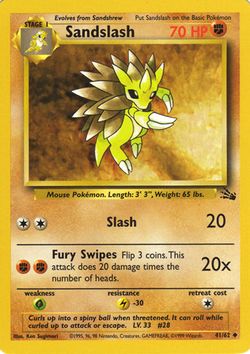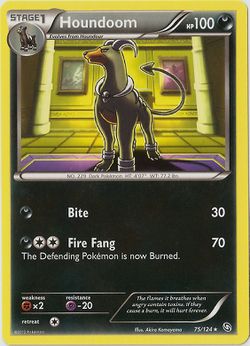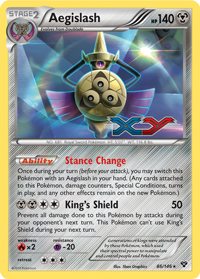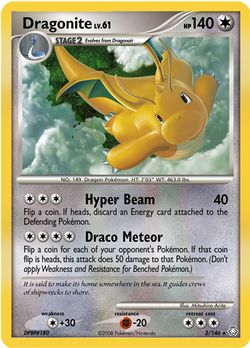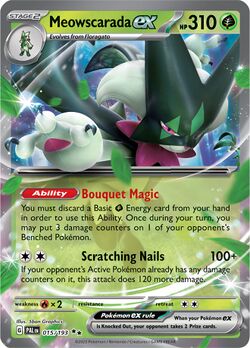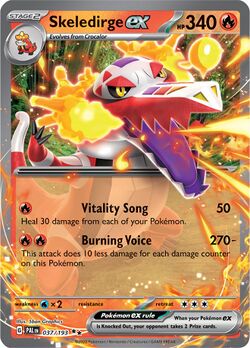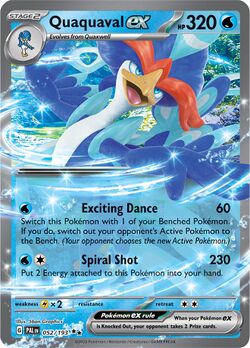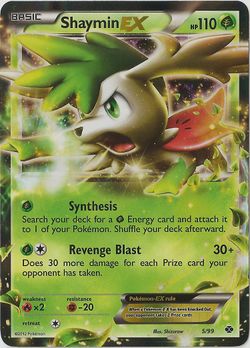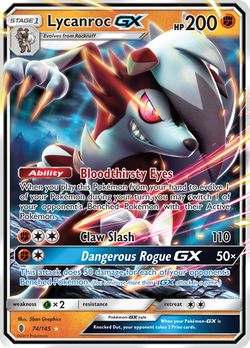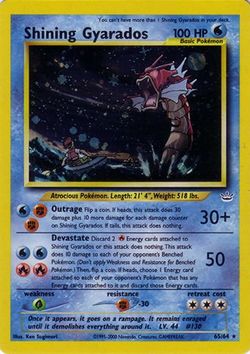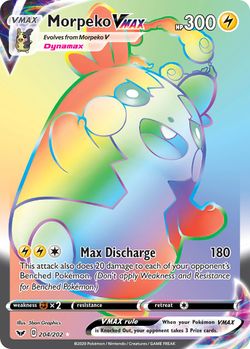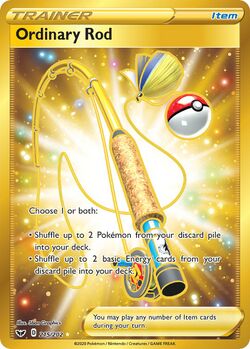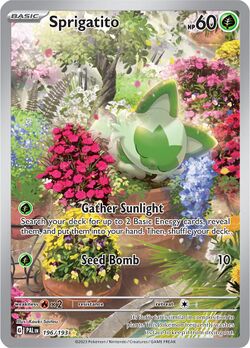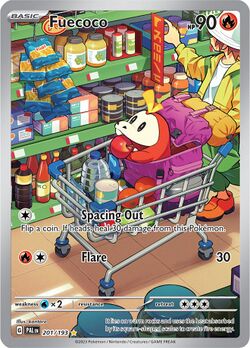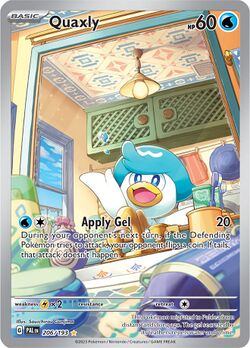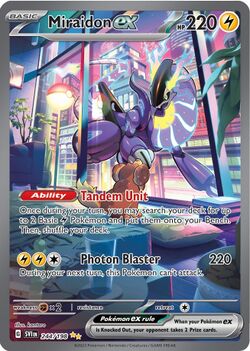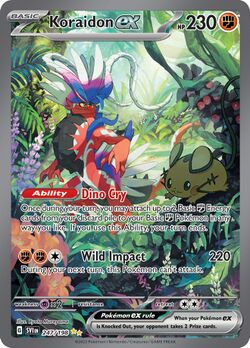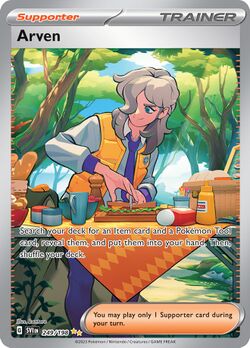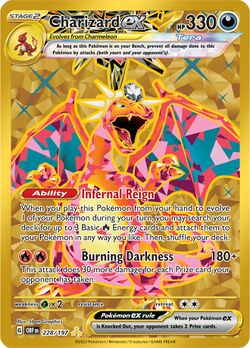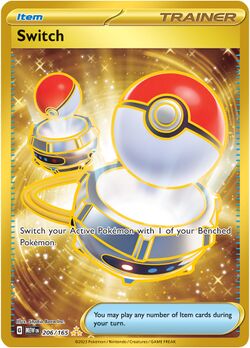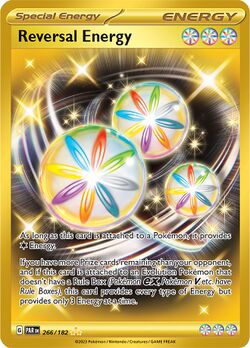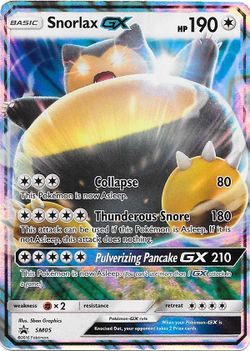Rarity: Difference between revisions
TyraniThrone (talk | contribs) mNo edit summary |
(minor touch ups, like the Radiant Pokémon description and also removed an instance of M Pokémon EX) |
||
| (62 intermediate revisions by 33 users not shown) | |||
| Line 1: | Line 1: | ||
{{search|a concept in the [[Pokémon Trading Card Game]]|a related concept in the core series video games|List of Pokémon by availability}} | |||
---- | |||
{{move|Rarity (TCG)}} | |||
{{incomplete|needs=many historical rarities}} | |||
[[File:BulbasaurDetectivePikachu1.jpg|thumb|250px|[[Bulbasaur (Detective Pikachu 1)|Bulbasaur]], a Common ({{rar|Common|}}/{{rar|C}}) card from the {{TCG|Detective Pikachu}} subset]] | |||
In the [[Pokémon Trading Card Game]], the '''rarity''' of a particular card (also known as the '''pull ratio''') describes how difficult it is to obtain that particular card within each [[List of Pokémon Trading Card Game expansions|expansion]]. Though rarity typically correlates to the actual frequency at which a card is found in official {{TCG|Booster pack}}s, some cards can be uncharacteristically common or rare for their official rarity. | |||
== | There are three main rarities, represented on each card by a symbol printed at the bottom of each card: Common ({{rar|Common}}), Uncommon ({{rar|Uncommon}}) and Rare ({{rar|Rare}}). Some of the more exclusive Rare cards are known as Ultra Rare ({{rar|Ultra-Rare Rare}}). Starting from [[Black & White (TCG)|ブラックコレクション ''Black Collection'' and ホワイトコレクション ''White Collection'']], Japanese releases, rather than using symbols, use bolded letters to denote rarity; for example, {{rar|C}}, {{rar|U}}, {{rar|R}} and {{rar|RR}}. Each non-promotional card released in an expansion pack has a set rarity. The rarity of a card may vary between Japanese and other-language releases; that is, a card which is Common ({{rar|C}}) in the Japanese release may be Uncommon ({{rar|Uncommon}}) in the English-language release (for example, [[Sudowoodo (Sword & Shield 100)]]). | ||
Every English-language {{TCG|Booster pack}} is guaranteed to contain at least 1 Rare ({{rar|Rare}}) card and generally 3 Uncommon ({{rar|Uncommon}}) cards; the remainder will usually be Common ({{rar|Common}}). Starting from the {{tcg|Legendary Collection}} expansion, each Booster pack is also guaranteed to contain 1 Reverse [[Holofoil]] card, which is a card of any Rarity with Holofoil printing on the background of the card but not on the image of the Pokémon, Trainer card, or Special Energy card. Basic {{TCG|Energy}} cards do not have a rarity. | |||
With the {{TCG|Scarlet & Violet}} expansion, the rarity scale was changed to correspond to the one used in Japan, however maintaining being marked by symbols. | |||
==Standard rarity== | |||
===Common=== | ===Common=== | ||
Common | Common cards are marked with a circle ({{rar|Common}}) and usually consist of basic, [[Evolution|unevolved]] Pokémon. Most English {{TCG|Booster pack}}s contain four to five Common cards. Common cards can also come in a Reverse [[Holofoil]] print. | ||
{| align="left" | |||
|- | |||
| colspan=3 | ''Examples of Common cards'' | |||
|- | |||
| | |||
{| | |||
! class="roundytop" style="text-align:center; margin:auto; background: #{{tcg grass color}}; border: 2px solid #{{tcg grass color dark}}; padding: 5px;" | {{color2|000|Grookey (Sword & Shield 11)}} | |||
|- | |||
| class="roundybottom" style="text-align:center; margin:auto; background: #fff; border: 2px solid #{{tcg grass color dark}}; padding: 5px;" | [[File:GrookeySwordShield11.jpg|250px]] | |||
|} | |||
| | |||
{| | |||
! class="roundytop" style="text-align:center; margin:auto; background: #{{tcg fire color}}; border: 2px solid #{{tcg fire color dark}}; padding: 5px;" | {{color2|000|Scorbunny (Sword & Shield 31)}} | |||
|- | |||
| class="roundybottom" style="text-align:center; margin:auto; background: #fff; border: 2px solid #{{tcg fire color dark}}; padding: 5px;" | [[File:ScorbunnySwordShield31.jpg|250px]] | |||
|} | |||
| | |||
{| | |||
! class="roundytop" style="text-align:center; margin:auto; background: #{{tcg water color}}; border: 2px solid #{{tcg water color dark}}; padding: 5px;" | {{color2|000|Sobble (Sword & Shield 55)}} | |||
|- | |||
| class="roundybottom" style="text-align:center; margin:auto; background: #fff; border: 2px solid #{{tcg water color dark}}; padding: 5px;" | [[File:SobbleSwordShield55.jpg|250px]] | |||
|} | |||
|} | |||
{{-}} | |||
===Uncommon=== | ===Uncommon=== | ||
Uncommon | Uncommon cards are marked with a diamond ({{rar|Uncommon}}) and can consist of both [[Evolution|evolved]] and unevolved Pokémon. The vast majority of {{TCG|Trainer card}}s are also at this rarity. Most English {{TCG|Booster pack}}s contain three Uncommon cards. Uncommon cards can also come in a Reverse [[Holofoil]] print. | ||
{| align="left" | |||
|- | |||
| colspan=3 | ''Examples of Uncommon cards'' | |||
|- | |||
| | |||
{| | |||
! class="roundytop" style="text-align:center; margin:auto; background: #{{tcg colorless color}}; border: 2px solid #{{tcg colorless color dark}}; padding: 5px;" | {{color2|000|Ultra Ball (Dark Explorers 102)}} | |||
|- | |||
| class="roundybottom" style="text-align:center; margin:auto; background: #fff; border: 2px solid #{{tcg lightning color dark}}; padding: 5px;" | [[File:UltraBallDarkExplorers102.jpg|250px]] | |||
|} | |||
| | |||
{| | |||
! class="roundytop" style="text-align:center; margin:auto; background: #{{tcg psychic color}}; border: 2px solid #{{tcg psychic color dark}}; padding: 5px;" | {{color2|000|Haunter (Stormfront 40)}} | |||
|- | |||
| class="roundybottom" style="text-align:center; margin:auto; background: #fff; border: 2px solid #{{tcg psychic color dark}}; padding: 5px;" | [[File:HaunterStormfront40.jpg|250px]] | |||
|} | |||
| | |||
{| | |||
! class="roundytop" style="text-align:center; margin:auto; background: #{{tcg fighting color}}; border: 2px solid #{{tcg fighting color dark}}; padding: 5px;" | {{color2|000|Sandslash (Fossil 41)}} | |||
|- | |||
| class="roundybottom" style="text-align:center; margin:auto; background: #fff; border: 2px solid #{{tcg fighting color dark}}; padding: 5px;" | [[File:SandslashFossil41.jpg|250px]] | |||
|} | |||
|} | |||
{{-}} | |||
===Rare=== | ===Rare=== | ||
Rare Pokémon are the | Rare cards are marked with a star ({{rar|Rare}}) and usually consist of [[Evolution|evolved]] and [[Legendary Pokémon]]. Most English {{TCG|Booster pack}}s contain at least one guaranteed Rare card. Rare cards can also come in a Reverse [[Holofoil]] print. If a Booster pack contains a Reverse Holofoil Rare card, this is in addition to the guaranteed Rare card. | ||
The guaranteed Rare card may come in one of four sub-classifications of Rare card: | |||
* '''Regular Rare''', which are marked with {{rar|Rare}} but do not have any holofoil design | |||
* '''Holofoil Rare''', which are marked with {{rar|Rare}} and also have a Holofoil design on the card art | |||
* '''Double Rare''', which are marked with {{rar|Double Rare}} and are {{TCG|Pokémon ex}} | |||
* '''Ultra Rare''' (before the {{TCG|Scarlet & Violet}} expansion), which are marked with {{rar|Ultra-Rare Rare}} and are typically associated with [[:Category:Pokémon card classifications|a unique card classification or mechanic]] such as {{TCG|Pokémon V}} | |||
* '''Ultra Rare''' (since the Scarlet & Violet expansion), which are marked with {{rar|Ultra Rare}} and are Full Art Pokémon ex or Supporter cards | |||
* '''{{TCG|Secret card|Secret Rare}}''', which are cards with set numbers outside the printed size of the set (for example, a card numbered 101/100), marked with {{rar|Ultra-Rare Rare}}, and have a unique artwork scheme such as a Rainbow Holofoil print. | |||
====Holofoil Rare==== | |||
{{main|Holofoil card}} | |||
A small amount of rare cards within each expansion are available as both Regular Rare and '''Holofoil Rare'''. These cards have a Holofoil pattern on the card art and are marked with {{rar|Rare}}. Cards which are available as either Regular Rare or Holofoil Rare are labelled with {{rar|Rare Holo}} on Bulbapedia. Holofoil Rare cards are rarer than regular Rare cards; a Holofoil Rare is not guaranteed in English Booster packs. Starting from {{TCG|Scarlet & Violet}}, all Rare cards in booster packs are now Holofoil Rares. | |||
There are many types of [[Holofoil card|Holofoil]], which occasionally changes after a series of expansions: | |||
* Between {{TCG|Base Set}} and {{TCG|Call of Legends}} (spanning every expansion from Generation I to IV), the holofoil pattern is named "Cosmos Holofoil", and consists of dots and circles of different sizes spread across the image of the Pokémon. This holofoil pattern is still frequently used for promotional cards and returned to the main sets for {{TCG|Evolutions}} only. | |||
* Between {{TCG|Black and White}} and {{TCG|Legendary Treasures}} (every expansion from Generation V), the holofoil pattern is named "Tinsel Holofoil", and consists of horizontal stripes across the image. In Japanese holofoil cards of these sets, the border of the card also has a tinsel holofoil effect. | |||
* Between {{TCG|XY}} and {{TCG|Steam Siege}}, the holofoil pattern is changed to "Sheen Holofoil". There are differences between the language of the card; Japanese holofoil cards refract light in a diagonal direction from bottom left to top right across the entire card; Korean holofoil cards have the same effect and direction, but only cover the image of the Pokémon; and international releases have the same effect as Japanese cards, but only cover the image, and the direction is from bottom right to top left. | |||
* Between {{TCG|Sun & Moon}} and {{TCG|Cosmic Eclipse}}, the holofoil pattern is called "Water-Web Holofoil". These cards refract light in a wave-like pattern in all releases. However, only the Japanese releases cover the border with the pattern. | |||
* Starting from {{TCG|Sword & Shield}}, the holofoil pattern is a series of thin vertical stripes that refract light from the top to the bottom of the image. | |||
* Starting from {{TCG|Scarlet & Violet}}, Holofoil Rare cards have a light-reflecting border. | |||
* Certain Theme Decks have exclusive versions of the featured card: in the Black and White era, the featured card had a Cracked Ice/Shattered effect. The same effect was used in some blisters as well. | |||
{| align="left" | |||
|- | |||
| colspan=3 | ''Examples of Regular Rare or Holofoil Rare cards'' | |||
|- | |||
| | |||
{| | |||
! class="roundytop" style="text-align:center; margin:auto; background: #{{tcg darkness color}}; border: 2px solid #{{tcg darkness color dark}}; padding: 5px;" | {{color2|fff|Houndoom (Dragons Exalted 75)}} | |||
|- | |||
| class="roundybottom" style="text-align:center; margin:auto; background: #fff; border: 2px solid #{{tcg darkness color dark}}; padding: 5px;" | [[File:HoundoomDragonsExalted75.jpg|250px]] | |||
|} | |||
| | |||
{| | |||
! class="roundytop" style="text-align:center; margin:auto; background: #{{tcg metal color}}; border: 2px solid #{{tcg metal color dark}}; padding: 5px;" | {{color2|000|Aegislash (XY 86)}} | |||
|- | |||
| class="roundybottom" style="text-align:center; margin:auto; background: #fff; border: 2px solid #{{tcg metal color dark}}; padding: 5px;" | [[File:AegislashXY86.jpg|250px]] | |||
|} | |||
| | |||
{| | |||
! class="roundytop" style="text-align:center; margin:auto; background: #{{tcg colorless color}}; border: 2px solid #{{tcg colorless color dark}}; padding: 5px;" | {{color2|000|Dragonite (Legends Awakened 2)}} | |||
|- | |||
| class="roundybottom" style="text-align:center; margin:auto; background: #fff; border: 2px solid #{{tcg colorless color dark}}; padding: 5px;" | [[File:DragoniteLegendsAwakened2.jpg|250px]] | |||
|} | |||
|} | |||
{{-}} | |||
====Shiny Rare==== | |||
The '''Shiny Rare''' rarity, sometimes called '''Shiny rare''', was introduced in {{TCG|Paldean Fates}}.<ref>[https://tcg.pokemon.com/en-us/expansions/paldean-fates/]</ref> It uses a single hollow gold star [[File:Rarity Shiny Rare.png|15px]]. It is only for [[Shiny Pokémon]], unless they qualify for a higher rarity. | |||
====Double Rare==== | |||
The '''Double Rare''' rarity was introduced in the {{TCG|Scarlet & Violet}} expansion and corresponds to the {{rar|RR}} rarity. It is marked with two stars ({{rar|Double Rare}}). {{TCG|Pokémon ex}} are of this rarity, and might replace the Rare card in a booster pack. | |||
{| align="left" | |||
|- | |||
| colspan=3 | ''Examples of Double Rare cards'' | |||
|- | |||
| | |||
{| | |||
! class="roundytop" style="text-align:center; margin:auto; background: #{{tcg grass color}}; border: 2px solid #{{tcg grass color dark}}; padding: 5px;" | {{color2|000|Meowscarada ex (Paldea Evolved 15)}} | |||
|- | |||
| class="roundybottom" style="text-align:center; margin:auto; background: #fff; border: 2px solid #{{tcg grass color dark}}; padding: 5px;" | [[File:MeowscaradaexPaldeaEvolved15.jpg|250px]] | |||
|} | |||
| | |||
{| | |||
! class="roundytop" style="text-align:center; margin:auto; background: #{{tcg fire color}}; border: 2px solid #{{tcg fire color dark}}; padding: 5px;" | {{color2|000|Skeledirge ex (Paldea Evolved 37)}} | |||
|- | |||
| class="roundybottom" style="text-align:center; margin:auto; background: #fff; border: 2px solid #{{tcg fighting color dark}}; padding: 5px;" | [[File:SkeledirgeexPaldeaEvolved37.jpg|250px]] | |||
|} | |||
| | |||
{| | |||
! class="roundytop" style="text-align:center; margin:auto; background: #{{tcg water color}}; border: 2px solid #{{tcg water color dark}}; padding: 5px;" | {{color2|000|Quaquaval ex (Paldea Evolved 52)}} | |||
|- | |||
| class="roundybottom" style="text-align:center; margin:auto; background: #fff; border: 2px solid #{{tcg water color dark}}; padding: 5px;" | [[File:QuaquavalexPaldeaEvolved52.jpg|250px]] | |||
|} | |||
|} | |||
{{-}} | |||
====Ultra Rare==== | |||
'''Ultra Rare''' (sometimes known as '''Super Rare''') cards are typically marked as Rare [[Holofoil]] cards, but sometimes have unique symbols denoting their rarity. As such, they will replace the rare card in the {{TCG|Booster pack}}. As their name suggests, ultra rare cards are far more difficult to acquire than typical rare cards. Most ultra rare cards are associated with a unique mechanic, such as {{TCG|Pokémon-ex}}, {{TCG|Pokémon LV.X|Pokémon LV.''X''}}, {{TCG|Pokémon LEGEND}}, {{TCG|Pokémon-EX}}, or {{TCG|Pokémon V}}. | |||
* '''{{TCG|Pokémon ex}}''' were introduced in {{TCG|EX Ruby & Sapphire}}. These Pokémon are more powerful than other Pokémon, but if they are Knocked Out the opponent takes two [[Prize card]]s instead of one. They have a cosmos holofoil effect in the image as well as on the border of the card. They usually are not Secret Cards, with exceptions like Rocket's Raikou ex or Rocket's Persian ex. | |||
* '''{{TCG|Pokémon Star}}''' were introduced in [[EX Team Rocket Returns]]. They are alternatively colored Pokémon with stronger attacks, but only one Pokémon Star can be an a deck. Portions of the Pokémon extend outside the borders of the artwork, Golden tinges and holographic shadows are added to various parts of the card. Their unique rarity is called rare Holo ☆ ([[File:Rare Holo ☆.png]]). | |||
* '''{{TCG|Pokémon LV.X}}''' were introduced in {{TCG|Diamond & Pearl}}. They have holofoil borders from Pokémon ex and art that pops out of the frame from Pokémon Star. They "[[level|Level-Up]] from other Pokémon, which is similar but not identical to evolution, meaning they keep certain characteristics of the prior card. They have the rarity of rare Holo LV.X ([[File:Rarity Rare Holo LV.X.png]]). | |||
* '''{{TCG|Pokémon LEGEND}}''' were introduced in {{TCG|HeartGold & SoulSilver}}, depicting Legendary Pokémon. A single Pokémon LEGEND card only depicts half of a Pokémon, so both halves have to be played at the same time. (Some cards depict two Pokémon, and when they are Knocked Out the opponent takes two Prize Cards) The illustration takes up three-quarters of the combined Pokémon, with attacks, {{TCG|Poké-Power}} and {{TCG|Poké-Body|Poké-Bodies}} in the remaining space of the bottom card. The entire card is holofoil, and their rarity is is Rare Holofoil LEGEND ([[File:Rarity Rare Holo LEGEND.png]]). | |||
* '''{{TCG|Pokémon Prime}}''' were introduced in {{TCG|HeartGold & SoulSilver}}. They are stronger than normal Pokémon, but distinctly do not have a name change or a distinct mechanic. They have a special card design, using 'leering' eyes and a special design at the edge of the image border), and both the name and artwork are holographic. Their rarity is Rare Prime ([[File:Rarity Rare Prime.png]]). | |||
* '''{{TCG|Pokémon-EX}}''' were introduced in {{TCG|Next Destinies}}. Usually, they are Basic Pokémon. They are stronger than normal Pokemon and when they are Knocked Out the opponent takes two Prize Cards. Most, but not all, of the cards have a [[Full Art card (TCG)|Full Art]] print as well, where the image covers the whole card. Similar to Pokémon LV.X, the Pokémon 'break' the borders of the image, seeming to 'come' out of the image. An additional special effect is included on the border of each card, based on the characteristic of the card, such as leaves on the border of Shaymin-EX's card. Their rarity is rare Holo EX ([[File:Rarity Rare Holo EX.png]]). | |||
** '''{{TCG|Pokémon-EX|Mega Evolution Pokémon}}''' are a kind of Pokémon-EX introduced in {{TCG|XY}}. They depict [[Mega Evolution|Mega-Evolved Pokémon]], and they evolve from Pokémon-EX. The name of its attack in another language is used an an effect in in the artwork: The English name of the attack is used as an effect on Japanese and Korean cards, and the Japanese name of the attack is used as an effect on international releases). They are also rare Holo EX. | |||
* '''{{TCG|ACE SPEC card}}s''' are cards introduced in {{TCG|Boundaries Crossed}}. These non-Pokémon cards are very powerful, but a deck is only allowed to have one ACE SPEC. They have grey designs with red and blue accents. Their rarity is rare ACE ([[File:Rarity Rare ACE.png]]). When they were reintroduced in {{TCG|Temporal Forces}}, the base color became magenta with blue as an accent. Their rarity became ACE SPEC Rare ([[File:Rarity ACE SPEC Rare.png|15px]]). | |||
* {{TCG|Pokémon BREAK}} were introduced in {{TCG|BREAKthrough}}. These cards undergo BREAK Evolution, which lets them keep some of the characteristics of what they evolve from. Their artwork shows golden Pokémon on holofoil backgrounds with a square pattern. They are oriented sideways. Their rarity is rare BREAK ([[File:Rarity Rare BREAK.png]]). | |||
* '''{{TCG|Pokémon-GX}}''' were introduced in {{TCG|Sun & Moon}}. These cards have a special extra powerful GX attack, but each player can only use one GX attack per game. They are stronger than other Pokémon, but when they are Knocked Out the opponent takes two Prize Cards. Pokémon-GX have one of three rarities, two of which are considered to be "Ultra Rare" when featured in main sets. These two are the normal variant, whose artwork covers most of the card, and like Pokémon-EX, the [[Full Art card (TCG)|Full Art]] variant. However, as is noted below, the Full Art variants are not considered Ultra Rare in the Japanese releases, but instead are Secret cards. Their rarity is rare Holo GX ([[File:Rarity Rare Holo GX.png]]). | |||
** '''{{TCG|Pokémon-GX|Tag Team Pokémon-GX}}''' were introduced in {{TCG|Team Up}}. They depict two Pokémon working together, and their GX attacks have a distinct mechanic where certain circumstances grant a bonus effect. They are always Basic Pokémon, but when they are Knocked Out the opponent takes three Prize Cards. They have the same [[Full Art card (TCG)|Full Art]] variants as regular Pokémon-GX, and have a second variant which expands on the story behind the Pokémon shown on the card (sometimes found as a promo card instead). Both of these variants are Secret cards in the Japanese releases, however. They are also rare Holo GX. | |||
* '''{{TCG|Prism Star|Prism Star cards}}''' were introduced in {{TCG|Ultra Prism}}. Only one copy of each card can be in a deck. If the card would go to the discard pile, it instead goes to to the [[Lost Zone]]. The border of these cards is black, and various elements have a rainbow tint. They have a rarity of rare Prism Star ([[File:Rarity Rare Prism Star.png]]). | |||
* '''{{TCG|Pokémon V}}''' were introduced in {{TCG|Sword & Shield}}. They are stronger than normal Pokémon but when they are Knocked Out the opponent takes two Prize cards. They are usually Basic Pokémon They have black borders, large illustrations that are not in a dedicated box, and a black "V" logo in the top left corner. Some Pokémon V have a [[Full Art card (TCG)|Full Art]] variant. Their rarity is holo rare V ([[File:Rarity Holo Rare V.png]]). | |||
**'''{{TCG|Pokémon VMAX}}''' are a kind of Pokémon V that were also introduced in {{TCG|Sword & Shield}}, as evolutions of Pokémon V. They depict [[Dynamax]], [[Gigantamax]], and [[Eternamax]] Pokémon. When they are Knocked Out the opponent takes three Prize cards. All Pokémon VMAX cards are printed in the Full Art style. Their rarity is holo rare VMAX ([[File:Rarity Holo Rare VMAX.png]]). | |||
**'''{{TCG|Pokémon VSTAR}}''' are a kind of Pokémon V that were introduced in {{TCG|Brilliant Stars}}, as evolutions of Pokémon V. Each one has a special attack or Ability called a VSTAR Power, but each player can only use one VSTAR Power per game. The black colors of Pokémon V cards are replaced with white, with gold as an accent. The Pokémon has a gold aura around it, while the text with the VSTAR Power has a space background incorporating a star. Their rarity is holo rare VSTAR ([[File:Rarity Holo Rare VSTAR.png]]). | |||
**'''{{TCG|Pokémon V-UNION}}''' are a kind of Pokémon V only available as {{TCG|SWSH Black Star Promos|SWSH Black Star Promotional cards}}. They consist of four cards, all of which must be played at the same time from the discard pile. Text is on all four cards. The border's texture resembles stone, with some parts breaking away and therefore removing the border. They do not have a rarity. | |||
*'''{{TCG|Amazing Pokémon}}''' were introduced in {{TCG|Vivid Voltage}}. The background of an Amazing Pokémon is a swirl of multiple colors that extends outside of the box for artwork. The name of the card is not changed. Their rarity is Amazing rare ([[File:Rarity Amazing Rare.png|15px]]). | |||
*'''{{TCG|Radiant Pokémon}}''' were introduced in {{TCG|Astral Radiance}}. These cards show [[Shiny Pokémon]], and a deck can only include one Radiant Pokémon. They have a special holofoil layer. Their rarity is Radiant rare ([[File:Rarity Radiant Rare.png|30px]]). | |||
Starting in the {{TCG|Scarlet & Violet}} expansion, this rarity is denoted with two silver stars ({{rar|Ultra Rare}}). Only Full Art {{TCG|Pokémon ex}} and Supporter cards are of this rarity, regular prints of Pokémon ex are instead Double Rare cards. Staring in {{TCG|Paldean Fates}}, Shiny Pokémon that are printings of normally Ultra Rare cards have the rarity Shiny Ultra Rare ([[File:Rarity Shiny Ultra Rare.png|15px]]). It is idicated by two hollow gold stars. | |||
{| align="left" | |||
|- | |||
| colspan=3 | ''Examples of Ultra Rare cards'' | |||
|- | |||
| | |||
{| | |||
! class="roundytop" style="text-align:center; margin:auto; background: #{{tcg grass color}}; border: 2px solid #{{tcg grass color dark}}; padding: 5px;" | {{color2|000|Shaymin-EX (Next Destinies 5)}} | |||
|- | |||
| class="roundybottom" style="text-align:center; margin:auto; background: #fff; border: 2px solid #{{tcg grass color dark}}; padding: 5px;" | [[File:ShayminEXNextDestinies5.jpg|250px]] | |||
|} | |||
| | |||
{| | |||
! class="roundytop" style="text-align:center; margin:auto; background: #{{tcg fighting color}}; border: 2px solid #{{tcg fighting color dark}}; padding: 5px;" | {{color2|000|Lycanroc-GX (Guardians Rising 74)}} | |||
|- | |||
| class="roundybottom" style="text-align:center; margin:auto; background: #fff; border: 2px solid #{{tcg fighting color dark}}; padding: 5px;" | [[File:LycanrocGXGuardiansRising74.jpg|250px]] | |||
|} | |||
| | |||
{| | |||
! class="roundytop" style="text-align:center; margin:auto; background: #{{tcg water color}}; border: 2px solid #{{tcg water color dark}}; padding: 5px;" | {{color2|000|Lapras VMAX (Sword & Shield 50)}} | |||
|- | |||
| class="roundybottom" style="text-align:center; margin:auto; background: #fff; border: 2px solid #{{tcg water color dark}}; padding: 5px;" | [[File:LaprasVMAXSwordShield50.jpg|250px]] | |||
|} | |||
|} | |||
{{-}} | |||
====Secret Rare==== | |||
{{main|Secret card (TCG)}} | |||
Secret rare cards are cards with set numbers outside the printed size of the set (for example, a card numbered 101/100). These cards are generally considered a subset of ultra rares. Most secret rare cards are reprints of other cards, often from the same set, but with a unique artwork scheme such as an alternate holofoil scheme, depiction of [[shiny Pokémon]], or a gold trim. [[Shiny Pokémon|Shining Pokémon]] and {{TCG|Crystal Pokémon}} are both examples of secret rares. | |||
Previously, there were sparse amounts of Secret Rare cards released through various means, in which many were included as boxtoppers. Before the BW era, Secret cards mostly appeared in English versions, as they were either within normal set numbering or as promo cards in Japanese. | |||
After the release of {{TCG|Black & White}}, certain types of cards were released as Secret cards; they are explained below. | |||
* Box Toppers are [[Holofoil]] cards included within a booster box as a reward for buying the whole box. Although they were Secret cards, they had regular holofoil artwork and had a regular rarity of Holofoil Rare ([[File: Rarity Rare Holo.png]]). | |||
* {{TCG|Shining Pokémon}} had the shiny colorations that appeared in the Pokémon games, as well as the odds of encountering one (1/300, similar to in the games). Not only are they outside the set (having a number above the number of cards in the set), they were also the first to have the rarity Shining Holofoil ([[File: Rarity Shining Holo.png]]) to imitate the shiny sprite from the games ([[File:ShinyIIStars.png]]). Shining Pokémon could use multiple Energy-type attacks, but there could only be one Shining Pokémon per deck. [[Shining Gyarados (Neo Revelation 65)]] and [[Shining Magikarp (Neo Revelation 66)]] were the two first featured, perhaps due to their appearance in the anime and games, and were cosmos holofoils. The second and last set to feature Shining Pokémon was Neo Destiny, but the Pokémon itself (not the whole image) were given reflective foil treatment (to make the Pokémon really seem to 'shine'). The were also given the Shining Holofoil rarity. | |||
* The concept of Shining Pokémon was carried over to {{TCG|Crystal Pokémon}}, which were released in Aquapolis. Crystal Pokémon were all Colorless in type, regardless of their normal type; they had the cosmos holofoil treatment, were Secret Rares (outside the set) as well as having the multi Energy-type attacks, but were not actually alternatively colored as in Shining Pokémon. All Crystal Pokémon have the ''Crystal Type'' Poké-Body, which changes the Pokémon's type to the type of the Energy that is placed onto it if it is one of the three Energy-types that the Pokémon requires in its attacks. Crystal Pokémon appeared in Skyridge, but did not appear in the future. They have a rarity of Holo Rare in English ([[File: Rarity Rare Holo.png]]) and Super Rare in Japanese ([[File: Rarity SuperRare Holo.png]]). | |||
* In the BW era, the first Secret cards to appear were popular Pokémon not native to Unova, as only Unova Pokémon were released in the first three sets. Two of these cards were released - Pikachu and Meowth. The Pokémon image was holofoil, and there was a holofoil design under the main text of the Pokémon's type. | |||
* In {{TCG|Next Destinies}}, Shiny Pokémon were released as Secret cards, as Pokémon not native to Unova were included into the expansions. They had the same designs (holofoil image, holofoil energy type under main text) as the previous Secret cards. | |||
* In {{TCG|Dark Explorers}}, certain item cards were given Secret card prints as well. Various parts of the card (such as the border, or the text box of the name of the card) were golden; the image was holofoil, and there was a Poké Ball design printed under the main text. Some were even given redesigns - an example would be the Random Receiver, which was golden instead of black. Starting with {{TCG|Sun & Moon}}, these cards began to have art that covered the full card. Later, Pokémon, Energy cards, Pokémon Tool cards, and Stadium cards could be of this rarity. Starting with {{TCG|Scarlet & Violet}}, they now have the Hyper Rare rarity. | |||
* {{TCG|Legendary Treasures}} featured two special Secret cards: Reshiram and Zekrom were given an additional Full Art print, in which the whole card was golden. | |||
* From {{TCG|Flashfire}} onward, printings of Mega Evolution Pokémon cards with golden borders were released as Secret cards. | |||
* Full Art prints of Pokémon were introduced in {{TCG|Black & White}}. Later, Full Art prints of Supporters were introduced in {{TCG|Noble Victories}}. Full Art prints of Pokémon-EX and Pokémon-GX were introduced alongside their respective mechanics in {{TCG|Next Destinies}} and {{TCG|Sun & Moon}} respectively. However, Full Art cards were notably only considered "secret" in Japan, as these cards were within the numbering every English set, and therefore not Secret cards. Starting in the Scarlet & Violet expansion, Full Art cards are now Ultra Rare cards, and they are secret cards. | |||
* Rainbow Rare prints of most Pokémon-GX were introduced alongside the mechanic in {{TCG|Sun & Moon}}. Unlike their Full Art counterparts, they are Secret cards in every region. These cards feature the same art as their Full Art variants, but all have a rainbow holographic color instead of the actual color of the Pokémon that is present on the Full Art variant. From {{TCG|Sword & Shield}} to {{TCG|Silver Tempest}}, there were also Rainbow Rare Supporter cards. | |||
{| align="left" | |||
|- | |||
| colspan=3 | ''Examples of Secret Rare cards'' | |||
|- | |||
| | |||
{| | |||
! class="roundytop" style="text-align:center; margin:auto; background: #{{tcg water color}}; border: 2px solid #{{tcg water color dark}}; padding: 5px;" | {{color2|000|Shining Gyarados (Neo Revelation 65)}} | |||
|- | |||
| class="roundybottom" style="text-align:center; margin:auto; background: #fff; border: 2px solid #{{tcg water color dark}}; padding: 5px;" | [[File:ShiningGyaradosNeoRevelation65.jpg|250px]] | |||
|} | |||
| | |||
{| | |||
! class="roundytop" style="text-align:center; margin:auto; background: #{{tcg lightning color}}; border: 2px solid #{{tcg lightning color dark}}; padding: 5px;" | {{color2|000|Morpeko VMAX (Sword & Shield 204)}} | |||
|- | |||
| class="roundybottom" style="text-align:center; margin:auto; background: #fff; border: 2px solid #{{tcg lightning color dark}}; padding: 5px;" | [[File:MorpekoVMAXSwordShield204.jpg|250px]] | |||
|} | |||
| | |||
{| | |||
! class="roundytop" style="text-align:center; margin:auto; background: #{{tcg trainer color}}; border: 2px solid #{{tcg trainer color dark}}; padding: 5px;" | {{color2|000|Ordinary Rod (Sword & Shield 215)}} | |||
|- | |||
| class="roundybottom" style="text-align:center; margin:auto; background: #fff; border: 2px solid #{{tcg trainer color dark}}; padding: 5px;" | [[File:OrdinaryRodSwordShield215.jpg|250px]] | |||
|} | |||
|} | |||
{{-}} | |||
====Illustration Rare==== | |||
The '''{{TCG|Illustration rare card|Illustration Rare}}''' rarity was introduced in the {{TCG|Scarlet & Violet}} expansion and corresponds to the {{rar|AR}} rarity. It is marked with a gold star ({{rar|Illustration Rare}}). Some Full Art Pokémon, except {{TCG|Pokémon ex}}, are of this rarity and might replace the second Reverse Holo card in a booster pack. | |||
{| align="left" | |||
|- | |||
| colspan=3 | ''Examples of Illustration Rare cards'' | |||
|- | |||
| | |||
{| | |||
! class="roundytop" style="text-align:center; margin:auto; background: #{{tcg grass color}}; border: 2px solid #{{tcg grass color dark}}; padding: 5px;" | {{color2|000|Sprigatito (Paldea Evolved 196)}} | |||
|- | |||
| class="roundybottom" style="text-align:center; margin:auto; background: #fff; border: 2px solid #{{tcg grass color dark}}; padding: 5px;" | [[File:SprigatitoPaldeaEvolved196.jpg|250px]] | |||
|} | |||
| | |||
{| | |||
! class="roundytop" style="text-align:center; margin:auto; background: #{{tcg fire color}}; border: 2px solid #{{tcg fire color dark}}; padding: 5px;" | {{color2|000|Fuecoco (Paldea Evolved 201)}} | |||
|- | |||
| class="roundybottom" style="text-align:center; margin:auto; background: #fff; border: 2px solid #{{tcg fighting color dark}}; padding: 5px;" | [[File:FuecocoPaldeaEvolved201.jpg|250px]] | |||
|} | |||
| | |||
{| | |||
! class="roundytop" style="text-align:center; margin:auto; background: #{{tcg water color}}; border: 2px solid #{{tcg water color dark}}; padding: 5px;" | {{color2|000|Quaxly (Paldea Evolved 206)}} | |||
|- | |||
| class="roundybottom" style="text-align:center; margin:auto; background: #fff; border: 2px solid #{{tcg water color dark}}; padding: 5px;" | [[File:QuaxlyPaldeaEvolved206.jpg|250px]] | |||
|} | |||
|} | |||
{{-}} | |||
====Special Illustration Rare==== | |||
The '''{{TCG|Special illustration rare card|Special Illustration Rare}}''' rarity was introduced in the {{TCG|Scarlet & Violet}} expansion and corresponds to the {{rar|SAR}} rarity. It is marked with two gold stars ({{rar|Special Illustration Rare}}). Some Full Art {{TCG|Pokémon ex}} and Supporter cards are of this rarity and might replace the second Reverse Holo card in a booster pack. | |||
{| align="left" | |||
|- | |||
| colspan=3 | ''Examples of Special Illustration Rare cards'' | |||
|- | |||
| | |||
{| | |||
! class="roundytop" style="text-align:center; margin:auto; background: #{{tcg lightning color}}; border: 2px solid #{{tcg lightning color dark}}; padding: 5px;" | {{color2|000|Miraidon ex (Scarlet & Violet 244)}} | |||
|- | |||
| class="roundybottom" style="text-align:center; margin:auto; background: #fff; border: 2px solid #{{tcg lightning color dark}}; padding: 5px;" | [[File:MiraidonexScarletViolet244.jpg|250px]] | |||
|} | |||
| | |||
{| | |||
! class="roundytop" style="text-align:center; margin:auto; background: #{{tcg fighting color}}; border: 2px solid #{{tcg fighting color dark}}; padding: 5px;" | {{color2|000|Koraidon ex (Scarlet & Violet 247)}} | |||
|- | |||
| class="roundybottom" style="text-align:center; margin:auto; background: #fff; border: 2px solid #{{tcg fighting color dark}}; padding: 5px;" | [[File:KoraidonexScarletViolet247.jpg|250px]] | |||
|} | |||
| | |||
{| | |||
! class="roundytop" style="text-align:center; margin:auto; background: #{{tcg supporter color}}; border: 2px solid #{{tcg supporter color dark}}; padding: 5px;" | {{color2|000|Arven (Scarlet & Violet 249)}} | |||
|- | |||
| class="roundybottom" style="text-align:center; margin:auto; background: #fff; border: 2px solid #{{tcg supporter color dark}}; padding: 5px;" | [[File:ArvenScarletViolet249.jpg|250px]] | |||
|} | |||
|} | |||
{{-}} | |||
====Hyper Rare==== | |||
The '''{{TCG|Hyper rare card|Hyper Rare}}''' rarity was introduced in the {{TCG|Scarlet & Violet}} expansion and corresponds to the {{rar|UR}} rarity. It is marked with three gold stars ({{rar|Hyper Rare}}). Cards of any type, except for Supporter cards, are of this rarity and might replace the second Reverse Holo card in a booster pack. | |||
{| align="left" | |||
|- | |||
| colspan=3 | ''Examples of Hyper Rare cards'' | |||
|- | |||
| | |||
{| | |||
! class="roundytop" style="text-align:center; margin:auto; background: #{{tcg darkness color}}; border: 2px solid #{{tcg darkness color dark}}; padding: 5px;" | {{color2|000|Charizard ex (Obsidian Flames 228)}} | |||
|- | |||
| class="roundybottom" style="text-align:center; margin:auto; background: #fff; border: 2px solid #{{tcg darkness color dark}}; padding: 5px;" | [[File:CharizardexObsidianFlames228.jpg|250px]] | |||
|} | |||
| | |||
{| | |||
! class="roundytop" style="text-align:center; margin:auto; background: #{{tcg Item color}}; border: 2px solid #{{tcg Item color dark}}; padding: 5px;" | {{color2|000|Switch (151 206)}} | |||
|- | |||
| class="roundybottom" style="text-align:center; margin:auto; background: #fff; border: 2px solid #{{tcg Item color dark}}; padding: 5px;" | [[File:Switch209PokémonCard151.jpg|250px]] | |||
|} | |||
| | |||
{| | |||
! class="roundytop" style="text-align:center; margin:auto; background: #{{tcg rainbow color}}; border: 2px solid #{{tcg rainbow color dark}}; padding: 5px;" | {{color2|000|Reversal Energy (Paradox Rift 266)}} | |||
|- | |||
| class="roundybottom" style="text-align:center; margin:auto; background: #fff; border: 2px solid #{{tcg rainbow color dark}}; padding: 5px;" | [[File:ReversalEnergyParadoxRift266.jpg|250px]] | |||
|} | |||
|} | |||
{{-}} | |||
==Fixed rarity== | |||
===Trainer Kits, half decks and quarter decks=== | |||
Certain cards, such as those from certain decks (such as a [[Trainer Kit]] or some Japanese half or quarter decks) do not have a rarity listed on the bottom right corner of the card, and instead have the silhouette of the main Pokémon within the kit (such as the silhouette of {{p|Sylveon}} and {{p|Noivern}} in their respective half decks in the {{TCG|XY Trainer Kit}} — [[File:SylveonHalfDeckSymbol.png|20px]] '''/''' [[File:NoivernHalfDeckSymbol.png|25px]]). | |||
===Promos=== | |||
Promos are promotional cards released during an event (such as {{DL|Play! Pokémon|TCG Premier Events|TCG Championships}}) or in certain merchandise (such as in tins). They have a {{DL|Promotional cards (TCG)|Black Star Promos|Black Star Promo}} symbol ([[File:SetSymbolPromo.png|20px]]) instead of a rarity symbol in the bottom right corner. | |||
{| align="left" | |||
|- | |||
| colspan=3 | ''Examples of Fixed Rarity cards'' | |||
|- | |||
| | |||
{| | |||
! class="roundytop" style="text-align:center; margin:auto; background: #{{tcg fairy color}}; border: 2px solid #{{tcg fairy color dark}}; padding: 5px;" | {{color2|000|Sylveon (Sylveon Half Deck 15)}} | |||
|- | |||
| class="roundybottom" style="text-align:center; margin:auto; background: #fff; border: 2px solid #{{tcg fairy color dark}}; padding: 5px;" | [[File:SylveonSylveonHalfDeck15.jpg|250px]] | |||
|} | |||
| | |||
{| | |||
! class="roundytop" style="text-align:center; margin:auto; background: #{{tcg colorless color}}; border: 2px solid #{{tcg colorless color dark}}; padding: 5px;" | {{color2|000|Snorlax-GX (SM Promo 5)}} | |||
|- | |||
| class="roundybottom" style="text-align:center; margin:auto; background: #fff; border: 2px solid #{{tcg colorless color dark}}; padding: 5px;" | [[File:SnorlaxGXSMPromo5.jpg|250px]] | |||
|} | |||
|} | |||
== | {{-}} | ||
==References== | |||
<references/> | |||
{{Project TCG notice}} | |||
{{ | |||
[[Category: | [[Category:Pokémon Trading Card Game]] | ||
[[de:Seltenheit]] | [[de:Seltenheit]] | ||
[[es:Rareza]] | |||
[[fr:Rareté]] | |||
[[it:Rarità]] | |||
[[zh:稀有度(TCG)]] | |||
Latest revision as of 00:48, 4 September 2024
- This article is about the a concept in the Pokémon Trading Card Game. For a related concept in the core series video games, see List of Pokémon by availability.

|
It has been suggested that this article be moved to Rarity (TCG). Please discuss whether or not to move it on its talk page. |

|
This article is incomplete. Please feel free to edit this article to add missing information and complete it. Reason: many historical rarities |
In the Pokémon Trading Card Game, the rarity of a particular card (also known as the pull ratio) describes how difficult it is to obtain that particular card within each expansion. Though rarity typically correlates to the actual frequency at which a card is found in official Booster packs, some cards can be uncharacteristically common or rare for their official rarity.
There are three main rarities, represented on each card by a symbol printed at the bottom of each card: Common (![]() ), Uncommon (
), Uncommon (![]() ) and Rare (
) and Rare (![]() ). Some of the more exclusive Rare cards are known as Ultra Rare (
). Some of the more exclusive Rare cards are known as Ultra Rare (![]() ). Starting from ブラックコレクション Black Collection and ホワイトコレクション White Collection, Japanese releases, rather than using symbols, use bolded letters to denote rarity; for example,
). Starting from ブラックコレクション Black Collection and ホワイトコレクション White Collection, Japanese releases, rather than using symbols, use bolded letters to denote rarity; for example, ![]() ,
, ![]() ,
, ![]() and
and ![]() . Each non-promotional card released in an expansion pack has a set rarity. The rarity of a card may vary between Japanese and other-language releases; that is, a card which is Common (
. Each non-promotional card released in an expansion pack has a set rarity. The rarity of a card may vary between Japanese and other-language releases; that is, a card which is Common (![]() ) in the Japanese release may be Uncommon (
) in the Japanese release may be Uncommon (![]() ) in the English-language release (for example, Sudowoodo (Sword & Shield 100)).
) in the English-language release (for example, Sudowoodo (Sword & Shield 100)).
Every English-language Booster pack is guaranteed to contain at least 1 Rare (![]() ) card and generally 3 Uncommon (
) card and generally 3 Uncommon (![]() ) cards; the remainder will usually be Common (
) cards; the remainder will usually be Common (![]() ). Starting from the Legendary Collection expansion, each Booster pack is also guaranteed to contain 1 Reverse Holofoil card, which is a card of any Rarity with Holofoil printing on the background of the card but not on the image of the Pokémon, Trainer card, or Special Energy card. Basic Energy cards do not have a rarity.
). Starting from the Legendary Collection expansion, each Booster pack is also guaranteed to contain 1 Reverse Holofoil card, which is a card of any Rarity with Holofoil printing on the background of the card but not on the image of the Pokémon, Trainer card, or Special Energy card. Basic Energy cards do not have a rarity.
With the Scarlet & Violet expansion, the rarity scale was changed to correspond to the one used in Japan, however maintaining being marked by symbols.
Standard rarity
Common
Common cards are marked with a circle (![]() ) and usually consist of basic, unevolved Pokémon. Most English Booster packs contain four to five Common cards. Common cards can also come in a Reverse Holofoil print.
) and usually consist of basic, unevolved Pokémon. Most English Booster packs contain four to five Common cards. Common cards can also come in a Reverse Holofoil print.
| Examples of Common cards | ||||||||
|
|
| ||||||
Uncommon
Uncommon cards are marked with a diamond (![]() ) and can consist of both evolved and unevolved Pokémon. The vast majority of Trainer cards are also at this rarity. Most English Booster packs contain three Uncommon cards. Uncommon cards can also come in a Reverse Holofoil print.
) and can consist of both evolved and unevolved Pokémon. The vast majority of Trainer cards are also at this rarity. Most English Booster packs contain three Uncommon cards. Uncommon cards can also come in a Reverse Holofoil print.
| Examples of Uncommon cards | ||||||||
|
|
| ||||||
Rare
Rare cards are marked with a star (![]() ) and usually consist of evolved and Legendary Pokémon. Most English Booster packs contain at least one guaranteed Rare card. Rare cards can also come in a Reverse Holofoil print. If a Booster pack contains a Reverse Holofoil Rare card, this is in addition to the guaranteed Rare card.
) and usually consist of evolved and Legendary Pokémon. Most English Booster packs contain at least one guaranteed Rare card. Rare cards can also come in a Reverse Holofoil print. If a Booster pack contains a Reverse Holofoil Rare card, this is in addition to the guaranteed Rare card.
The guaranteed Rare card may come in one of four sub-classifications of Rare card:
- Regular Rare, which are marked with
 but do not have any holofoil design
but do not have any holofoil design - Holofoil Rare, which are marked with
 and also have a Holofoil design on the card art
and also have a Holofoil design on the card art - Double Rare, which are marked with
 and are Pokémon ex
and are Pokémon ex - Ultra Rare (before the Scarlet & Violet expansion), which are marked with
 and are typically associated with a unique card classification or mechanic such as Pokémon V
and are typically associated with a unique card classification or mechanic such as Pokémon V - Ultra Rare (since the Scarlet & Violet expansion), which are marked with
 and are Full Art Pokémon ex or Supporter cards
and are Full Art Pokémon ex or Supporter cards - Secret Rare, which are cards with set numbers outside the printed size of the set (for example, a card numbered 101/100), marked with
 , and have a unique artwork scheme such as a Rainbow Holofoil print.
, and have a unique artwork scheme such as a Rainbow Holofoil print.
Holofoil Rare
- Main article: Holofoil card
A small amount of rare cards within each expansion are available as both Regular Rare and Holofoil Rare. These cards have a Holofoil pattern on the card art and are marked with ![]() . Cards which are available as either Regular Rare or Holofoil Rare are labelled with
. Cards which are available as either Regular Rare or Holofoil Rare are labelled with ![]() on Bulbapedia. Holofoil Rare cards are rarer than regular Rare cards; a Holofoil Rare is not guaranteed in English Booster packs. Starting from Scarlet & Violet, all Rare cards in booster packs are now Holofoil Rares.
on Bulbapedia. Holofoil Rare cards are rarer than regular Rare cards; a Holofoil Rare is not guaranteed in English Booster packs. Starting from Scarlet & Violet, all Rare cards in booster packs are now Holofoil Rares.
There are many types of Holofoil, which occasionally changes after a series of expansions:
- Between Base Set and Call of Legends (spanning every expansion from Generation I to IV), the holofoil pattern is named "Cosmos Holofoil", and consists of dots and circles of different sizes spread across the image of the Pokémon. This holofoil pattern is still frequently used for promotional cards and returned to the main sets for Evolutions only.
- Between Black and White and Legendary Treasures (every expansion from Generation V), the holofoil pattern is named "Tinsel Holofoil", and consists of horizontal stripes across the image. In Japanese holofoil cards of these sets, the border of the card also has a tinsel holofoil effect.
- Between XY and Steam Siege, the holofoil pattern is changed to "Sheen Holofoil". There are differences between the language of the card; Japanese holofoil cards refract light in a diagonal direction from bottom left to top right across the entire card; Korean holofoil cards have the same effect and direction, but only cover the image of the Pokémon; and international releases have the same effect as Japanese cards, but only cover the image, and the direction is from bottom right to top left.
- Between Sun & Moon and Cosmic Eclipse, the holofoil pattern is called "Water-Web Holofoil". These cards refract light in a wave-like pattern in all releases. However, only the Japanese releases cover the border with the pattern.
- Starting from Sword & Shield, the holofoil pattern is a series of thin vertical stripes that refract light from the top to the bottom of the image.
- Starting from Scarlet & Violet, Holofoil Rare cards have a light-reflecting border.
- Certain Theme Decks have exclusive versions of the featured card: in the Black and White era, the featured card had a Cracked Ice/Shattered effect. The same effect was used in some blisters as well.
| Examples of Regular Rare or Holofoil Rare cards | ||||||||
|
|
| ||||||
Shiny Rare
The Shiny Rare rarity, sometimes called Shiny rare, was introduced in Paldean Fates.[1] It uses a single hollow gold star ![]() . It is only for Shiny Pokémon, unless they qualify for a higher rarity.
. It is only for Shiny Pokémon, unless they qualify for a higher rarity.
Double Rare
The Double Rare rarity was introduced in the Scarlet & Violet expansion and corresponds to the ![]() rarity. It is marked with two stars (
rarity. It is marked with two stars (![]() ). Pokémon ex are of this rarity, and might replace the Rare card in a booster pack.
). Pokémon ex are of this rarity, and might replace the Rare card in a booster pack.
| Examples of Double Rare cards | ||||||||
|
|
| ||||||
Ultra Rare
Ultra Rare (sometimes known as Super Rare) cards are typically marked as Rare Holofoil cards, but sometimes have unique symbols denoting their rarity. As such, they will replace the rare card in the Booster pack. As their name suggests, ultra rare cards are far more difficult to acquire than typical rare cards. Most ultra rare cards are associated with a unique mechanic, such as Pokémon-ex, Pokémon LV.X, Pokémon LEGEND, Pokémon-EX, or Pokémon V.
- Pokémon ex were introduced in EX Ruby & Sapphire. These Pokémon are more powerful than other Pokémon, but if they are Knocked Out the opponent takes two Prize cards instead of one. They have a cosmos holofoil effect in the image as well as on the border of the card. They usually are not Secret Cards, with exceptions like Rocket's Raikou ex or Rocket's Persian ex.
- Pokémon Star were introduced in EX Team Rocket Returns. They are alternatively colored Pokémon with stronger attacks, but only one Pokémon Star can be an a deck. Portions of the Pokémon extend outside the borders of the artwork, Golden tinges and holographic shadows are added to various parts of the card. Their unique rarity is called rare Holo ☆ (File:Rare Holo ☆.png).
- Pokémon LV.X were introduced in Diamond & Pearl. They have holofoil borders from Pokémon ex and art that pops out of the frame from Pokémon Star. They "Level-Up from other Pokémon, which is similar but not identical to evolution, meaning they keep certain characteristics of the prior card. They have the rarity of rare Holo LV.X (
 ).
). - Pokémon LEGEND were introduced in HeartGold & SoulSilver, depicting Legendary Pokémon. A single Pokémon LEGEND card only depicts half of a Pokémon, so both halves have to be played at the same time. (Some cards depict two Pokémon, and when they are Knocked Out the opponent takes two Prize Cards) The illustration takes up three-quarters of the combined Pokémon, with attacks, Poké-Power and Poké-Bodies in the remaining space of the bottom card. The entire card is holofoil, and their rarity is is Rare Holofoil LEGEND (
 ).
). - Pokémon Prime were introduced in HeartGold & SoulSilver. They are stronger than normal Pokémon, but distinctly do not have a name change or a distinct mechanic. They have a special card design, using 'leering' eyes and a special design at the edge of the image border), and both the name and artwork are holographic. Their rarity is Rare Prime (
 ).
). - Pokémon-EX were introduced in Next Destinies. Usually, they are Basic Pokémon. They are stronger than normal Pokemon and when they are Knocked Out the opponent takes two Prize Cards. Most, but not all, of the cards have a Full Art print as well, where the image covers the whole card. Similar to Pokémon LV.X, the Pokémon 'break' the borders of the image, seeming to 'come' out of the image. An additional special effect is included on the border of each card, based on the characteristic of the card, such as leaves on the border of Shaymin-EX's card. Their rarity is rare Holo EX (File:Rarity Rare Holo EX.png).
- Mega Evolution Pokémon are a kind of Pokémon-EX introduced in XY. They depict Mega-Evolved Pokémon, and they evolve from Pokémon-EX. The name of its attack in another language is used an an effect in in the artwork: The English name of the attack is used as an effect on Japanese and Korean cards, and the Japanese name of the attack is used as an effect on international releases). They are also rare Holo EX.
- ACE SPEC cards are cards introduced in Boundaries Crossed. These non-Pokémon cards are very powerful, but a deck is only allowed to have one ACE SPEC. They have grey designs with red and blue accents. Their rarity is rare ACE (
 ). When they were reintroduced in Temporal Forces, the base color became magenta with blue as an accent. Their rarity became ACE SPEC Rare (
). When they were reintroduced in Temporal Forces, the base color became magenta with blue as an accent. Their rarity became ACE SPEC Rare ( ).
). - Pokémon BREAK were introduced in BREAKthrough. These cards undergo BREAK Evolution, which lets them keep some of the characteristics of what they evolve from. Their artwork shows golden Pokémon on holofoil backgrounds with a square pattern. They are oriented sideways. Their rarity is rare BREAK (
 ).
). - Pokémon-GX were introduced in Sun & Moon. These cards have a special extra powerful GX attack, but each player can only use one GX attack per game. They are stronger than other Pokémon, but when they are Knocked Out the opponent takes two Prize Cards. Pokémon-GX have one of three rarities, two of which are considered to be "Ultra Rare" when featured in main sets. These two are the normal variant, whose artwork covers most of the card, and like Pokémon-EX, the Full Art variant. However, as is noted below, the Full Art variants are not considered Ultra Rare in the Japanese releases, but instead are Secret cards. Their rarity is rare Holo GX (
 ).
).
- Tag Team Pokémon-GX were introduced in Team Up. They depict two Pokémon working together, and their GX attacks have a distinct mechanic where certain circumstances grant a bonus effect. They are always Basic Pokémon, but when they are Knocked Out the opponent takes three Prize Cards. They have the same Full Art variants as regular Pokémon-GX, and have a second variant which expands on the story behind the Pokémon shown on the card (sometimes found as a promo card instead). Both of these variants are Secret cards in the Japanese releases, however. They are also rare Holo GX.
- Prism Star cards were introduced in Ultra Prism. Only one copy of each card can be in a deck. If the card would go to the discard pile, it instead goes to to the Lost Zone. The border of these cards is black, and various elements have a rainbow tint. They have a rarity of rare Prism Star (
 ).
). - Pokémon V were introduced in Sword & Shield. They are stronger than normal Pokémon but when they are Knocked Out the opponent takes two Prize cards. They are usually Basic Pokémon They have black borders, large illustrations that are not in a dedicated box, and a black "V" logo in the top left corner. Some Pokémon V have a Full Art variant. Their rarity is holo rare V (
 ).
).
- Pokémon VMAX are a kind of Pokémon V that were also introduced in Sword & Shield, as evolutions of Pokémon V. They depict Dynamax, Gigantamax, and Eternamax Pokémon. When they are Knocked Out the opponent takes three Prize cards. All Pokémon VMAX cards are printed in the Full Art style. Their rarity is holo rare VMAX (
 ).
). - Pokémon VSTAR are a kind of Pokémon V that were introduced in Brilliant Stars, as evolutions of Pokémon V. Each one has a special attack or Ability called a VSTAR Power, but each player can only use one VSTAR Power per game. The black colors of Pokémon V cards are replaced with white, with gold as an accent. The Pokémon has a gold aura around it, while the text with the VSTAR Power has a space background incorporating a star. Their rarity is holo rare VSTAR (
 ).
). - Pokémon V-UNION are a kind of Pokémon V only available as SWSH Black Star Promotional cards. They consist of four cards, all of which must be played at the same time from the discard pile. Text is on all four cards. The border's texture resembles stone, with some parts breaking away and therefore removing the border. They do not have a rarity.
- Pokémon VMAX are a kind of Pokémon V that were also introduced in Sword & Shield, as evolutions of Pokémon V. They depict Dynamax, Gigantamax, and Eternamax Pokémon. When they are Knocked Out the opponent takes three Prize cards. All Pokémon VMAX cards are printed in the Full Art style. Their rarity is holo rare VMAX (
- Amazing Pokémon were introduced in Vivid Voltage. The background of an Amazing Pokémon is a swirl of multiple colors that extends outside of the box for artwork. The name of the card is not changed. Their rarity is Amazing rare (
 ).
). - Radiant Pokémon were introduced in Astral Radiance. These cards show Shiny Pokémon, and a deck can only include one Radiant Pokémon. They have a special holofoil layer. Their rarity is Radiant rare (
 ).
).
Starting in the Scarlet & Violet expansion, this rarity is denoted with two silver stars (![]() ). Only Full Art Pokémon ex and Supporter cards are of this rarity, regular prints of Pokémon ex are instead Double Rare cards. Staring in Paldean Fates, Shiny Pokémon that are printings of normally Ultra Rare cards have the rarity Shiny Ultra Rare (
). Only Full Art Pokémon ex and Supporter cards are of this rarity, regular prints of Pokémon ex are instead Double Rare cards. Staring in Paldean Fates, Shiny Pokémon that are printings of normally Ultra Rare cards have the rarity Shiny Ultra Rare (![]() ). It is idicated by two hollow gold stars.
). It is idicated by two hollow gold stars.
| Examples of Ultra Rare cards | ||||||||
|
|
| ||||||
Secret Rare
- Main article: Secret card (TCG)
Secret rare cards are cards with set numbers outside the printed size of the set (for example, a card numbered 101/100). These cards are generally considered a subset of ultra rares. Most secret rare cards are reprints of other cards, often from the same set, but with a unique artwork scheme such as an alternate holofoil scheme, depiction of shiny Pokémon, or a gold trim. Shining Pokémon and Crystal Pokémon are both examples of secret rares. Previously, there were sparse amounts of Secret Rare cards released through various means, in which many were included as boxtoppers. Before the BW era, Secret cards mostly appeared in English versions, as they were either within normal set numbering or as promo cards in Japanese. After the release of Black & White, certain types of cards were released as Secret cards; they are explained below.
- Box Toppers are Holofoil cards included within a booster box as a reward for buying the whole box. Although they were Secret cards, they had regular holofoil artwork and had a regular rarity of Holofoil Rare (
 ).
). - Shining Pokémon had the shiny colorations that appeared in the Pokémon games, as well as the odds of encountering one (1/300, similar to in the games). Not only are they outside the set (having a number above the number of cards in the set), they were also the first to have the rarity Shining Holofoil (
 ) to imitate the shiny sprite from the games (
) to imitate the shiny sprite from the games ( ). Shining Pokémon could use multiple Energy-type attacks, but there could only be one Shining Pokémon per deck. Shining Gyarados (Neo Revelation 65) and Shining Magikarp (Neo Revelation 66) were the two first featured, perhaps due to their appearance in the anime and games, and were cosmos holofoils. The second and last set to feature Shining Pokémon was Neo Destiny, but the Pokémon itself (not the whole image) were given reflective foil treatment (to make the Pokémon really seem to 'shine'). The were also given the Shining Holofoil rarity.
). Shining Pokémon could use multiple Energy-type attacks, but there could only be one Shining Pokémon per deck. Shining Gyarados (Neo Revelation 65) and Shining Magikarp (Neo Revelation 66) were the two first featured, perhaps due to their appearance in the anime and games, and were cosmos holofoils. The second and last set to feature Shining Pokémon was Neo Destiny, but the Pokémon itself (not the whole image) were given reflective foil treatment (to make the Pokémon really seem to 'shine'). The were also given the Shining Holofoil rarity. - The concept of Shining Pokémon was carried over to Crystal Pokémon, which were released in Aquapolis. Crystal Pokémon were all Colorless in type, regardless of their normal type; they had the cosmos holofoil treatment, were Secret Rares (outside the set) as well as having the multi Energy-type attacks, but were not actually alternatively colored as in Shining Pokémon. All Crystal Pokémon have the Crystal Type Poké-Body, which changes the Pokémon's type to the type of the Energy that is placed onto it if it is one of the three Energy-types that the Pokémon requires in its attacks. Crystal Pokémon appeared in Skyridge, but did not appear in the future. They have a rarity of Holo Rare in English (
 ) and Super Rare in Japanese (
) and Super Rare in Japanese ( ).
). - In the BW era, the first Secret cards to appear were popular Pokémon not native to Unova, as only Unova Pokémon were released in the first three sets. Two of these cards were released - Pikachu and Meowth. The Pokémon image was holofoil, and there was a holofoil design under the main text of the Pokémon's type.
- In Next Destinies, Shiny Pokémon were released as Secret cards, as Pokémon not native to Unova were included into the expansions. They had the same designs (holofoil image, holofoil energy type under main text) as the previous Secret cards.
- In Dark Explorers, certain item cards were given Secret card prints as well. Various parts of the card (such as the border, or the text box of the name of the card) were golden; the image was holofoil, and there was a Poké Ball design printed under the main text. Some were even given redesigns - an example would be the Random Receiver, which was golden instead of black. Starting with Sun & Moon, these cards began to have art that covered the full card. Later, Pokémon, Energy cards, Pokémon Tool cards, and Stadium cards could be of this rarity. Starting with Scarlet & Violet, they now have the Hyper Rare rarity.
- Legendary Treasures featured two special Secret cards: Reshiram and Zekrom were given an additional Full Art print, in which the whole card was golden.
- From Flashfire onward, printings of Mega Evolution Pokémon cards with golden borders were released as Secret cards.
- Full Art prints of Pokémon were introduced in Black & White. Later, Full Art prints of Supporters were introduced in Noble Victories. Full Art prints of Pokémon-EX and Pokémon-GX were introduced alongside their respective mechanics in Next Destinies and Sun & Moon respectively. However, Full Art cards were notably only considered "secret" in Japan, as these cards were within the numbering every English set, and therefore not Secret cards. Starting in the Scarlet & Violet expansion, Full Art cards are now Ultra Rare cards, and they are secret cards.
- Rainbow Rare prints of most Pokémon-GX were introduced alongside the mechanic in Sun & Moon. Unlike their Full Art counterparts, they are Secret cards in every region. These cards feature the same art as their Full Art variants, but all have a rainbow holographic color instead of the actual color of the Pokémon that is present on the Full Art variant. From Sword & Shield to Silver Tempest, there were also Rainbow Rare Supporter cards.
| Examples of Secret Rare cards | ||||||||
|
|
| ||||||
Illustration Rare
The Illustration Rare rarity was introduced in the Scarlet & Violet expansion and corresponds to the ![]() rarity. It is marked with a gold star (
rarity. It is marked with a gold star (![]() ). Some Full Art Pokémon, except Pokémon ex, are of this rarity and might replace the second Reverse Holo card in a booster pack.
). Some Full Art Pokémon, except Pokémon ex, are of this rarity and might replace the second Reverse Holo card in a booster pack.
| Examples of Illustration Rare cards | ||||||||
|
|
| ||||||
Special Illustration Rare
The Special Illustration Rare rarity was introduced in the Scarlet & Violet expansion and corresponds to the ![]() rarity. It is marked with two gold stars (
rarity. It is marked with two gold stars (![]() ). Some Full Art Pokémon ex and Supporter cards are of this rarity and might replace the second Reverse Holo card in a booster pack.
). Some Full Art Pokémon ex and Supporter cards are of this rarity and might replace the second Reverse Holo card in a booster pack.
| Examples of Special Illustration Rare cards | ||||||||
|
|
| ||||||
Hyper Rare
The Hyper Rare rarity was introduced in the Scarlet & Violet expansion and corresponds to the ![]() rarity. It is marked with three gold stars (
rarity. It is marked with three gold stars (![]() ). Cards of any type, except for Supporter cards, are of this rarity and might replace the second Reverse Holo card in a booster pack.
). Cards of any type, except for Supporter cards, are of this rarity and might replace the second Reverse Holo card in a booster pack.
| Examples of Hyper Rare cards | ||||||||
|
|
| ||||||
Fixed rarity
Trainer Kits, half decks and quarter decks
Certain cards, such as those from certain decks (such as a Trainer Kit or some Japanese half or quarter decks) do not have a rarity listed on the bottom right corner of the card, and instead have the silhouette of the main Pokémon within the kit (such as the silhouette of Sylveon and Noivern in their respective half decks in the XY Trainer Kit — ![]() /
/ ![]() ).
).
Promos
Promos are promotional cards released during an event (such as TCG Championships) or in certain merchandise (such as in tins). They have a Black Star Promo symbol (![]() ) instead of a rarity symbol in the bottom right corner.
) instead of a rarity symbol in the bottom right corner.
| Examples of Fixed Rarity cards | |||||
|
| ||||
References

|
This article is part of Project TCG, a Bulbapedia project that aims to report on every aspect of the Pokémon Trading Card Game. |

